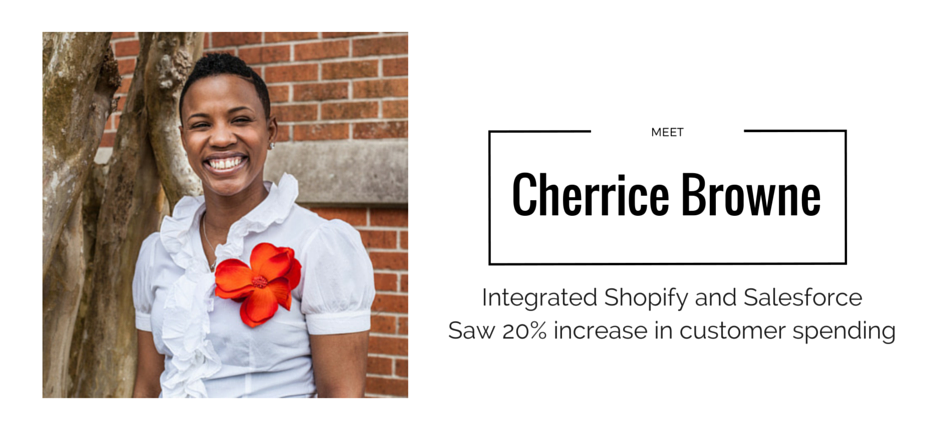If you are running any sort of eCommerce business using Shopify, connecting Shopify with your CRM is crucial. In fact, integration between Shopify and Salesforce can be the difference between constant exporting and uploading of CSV files, manual data manipulation and data entry, and the ability to segment your marketing efforts to increase your sales.
Workato customer Cherrice Brown streamlined the operations of her nonprofit by connecting Shopify and Salesforce. Then she used the data to segment her email marketing in MailChimp and keep their funds up to date in realtime with a QuickBooks integration. Having all of your POS data from Shopify directly synced with Salesforce puts a 360 degree view of a customer in real time at your disposal, making customer service better, email marketing more targeted and ultimately increasing your sales.
Cherrice’s Story

Tell us a little about your nonprofit:
The R.O.C.K. is a Houston, TX based nonprofit that works to strengthen communities through church programs by supporting families, acting as a center for educational development and more. We’re a small team of around 25 people and I’m the Director of Product Engineering.
How are you using your apps?
Our main revenue stream comes from the sale of products via our physical stores and our online storefront. I introduced cloud apps to our process so we could be more cost effective and reinvest funds into church programs. I chose Salesforce as our CRM, QuickBooks for our accounting, Shopify to run our storefront and MailChimp for our emails. We also have iPads to run our physical store, which makes mobile experience important for us.
“Because all orders are coming through Shopify and going into Salesforce via Workato, I can see everything a customer is doing with us, whether they bought a product online or offline.”
Why do you need these apps to integrate?
- We were losing data when we didn’t have our Salesforce and Shopify connected.
- Second, integration catches errors, if something doesn’t match, Workato will tell us.
- Third, we need up-to-date data and we need it to be accessible on our dashboard, it shouldn’t be a project just to find data.
At the end of the day, we’re such a small team that the extra time to manually do this stuff just isn’t viable.
Why did you choose Workato?
A few years ago, I did a lot of work in-house and I found that IT staff is quite expensive to maintain and the level of difficulty is much higher. I was also spending too much time pulling data and finding data from different people’s computers. Using cloud apps makes data accessible to everyone and Workato makes the data shared between apps.
When we moved to Shopify, we needed a way to aggregate information and get it into Salesforce. Without Workato, it would have cost us $40k-$50k and six months to get it going. With the way that Workato is set up, I can connect very complex systems with very little knowledge. If I needed to hand this off to someone who was not a technical person, could literally walk them through it and they would understand. Plus, the support people are the best! They answer and get it resolved.
How long did it take you to set up Workato?
We saw results immediately. I already understood what Workato was doing in theory, and after a quick tutorial I felt very comfortable. Workato is very easy to use and troubleshoot, I could’ve done it through FAQs even without the tutorial. Now that it’s set up, I can also easily pinpoint errors and the connections are great.
What are the biggest benefits of Workato’s integration?
There are so many! The point of having everything working together is to cut down on the time we spend on activities that don’t help us grow. For example, updating sales reports by hand – it doesn’t make money and it leaves room for error. Knowing how much money and where we can allocate it in real time is only possible because of our integration between Shopify, Salesforce, and QuickBooks. When I create a report I know it’s accurate and easily available. It’s also much less costly than custom solutions.
We’ve already seen an increase in sales after the integration. Because all orders are coming through Shopify and going into Salesforce via Workato, I can see everything a customer is doing with us, whether they bought a product online or offline. This helps us when we our sales reps are talking to them and all of their sales history is right there in Salesforce.
We also created our first-ever customer segmentation in MailChimp using the Salesforce data. In the past, this had to be exported from one app, manually manipulated in Excel, and imported to another app. Now I can make even more specific segments based on what people have bought like a segment for large purchasers or for people that have not yet made a purchase. The ability to quickly and easily create more targeted email marketing campaigns increased customer spending by 20%.
Connect Shopify and Salesforce
The ministry also saved an estimated $200,000 in labor costs by reducing manual data extraction. Cherrice and her colleagues can now focus on what matters the most: growing the ministry’s programs and positive impact worldwide.
Do you want to automate your workflow? Explore Workato >

